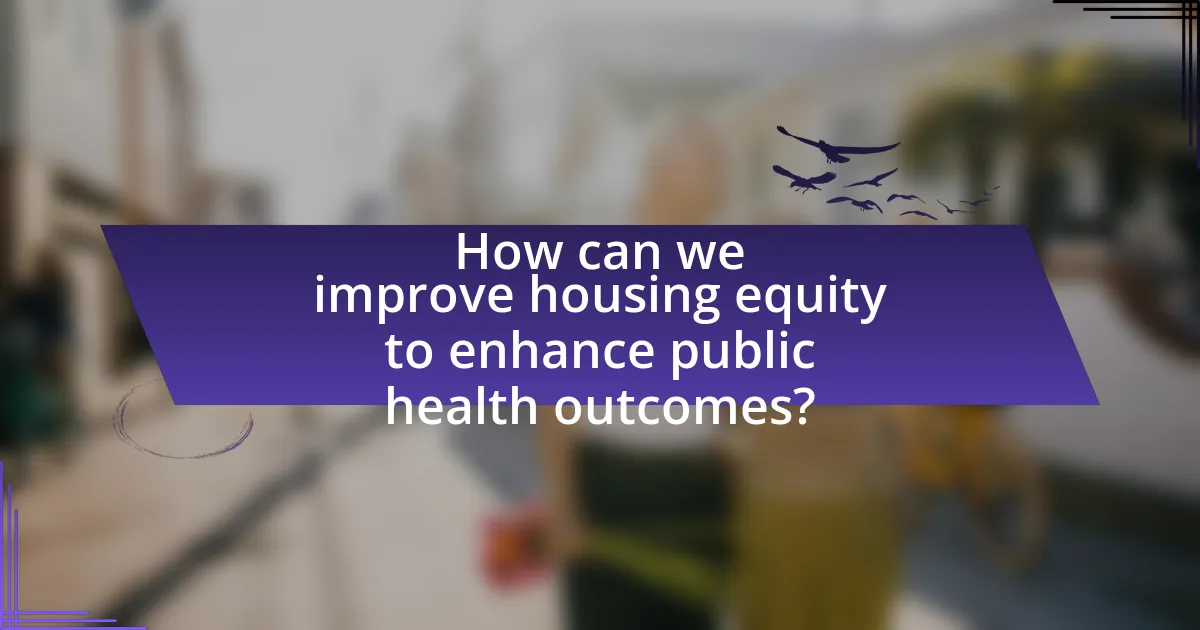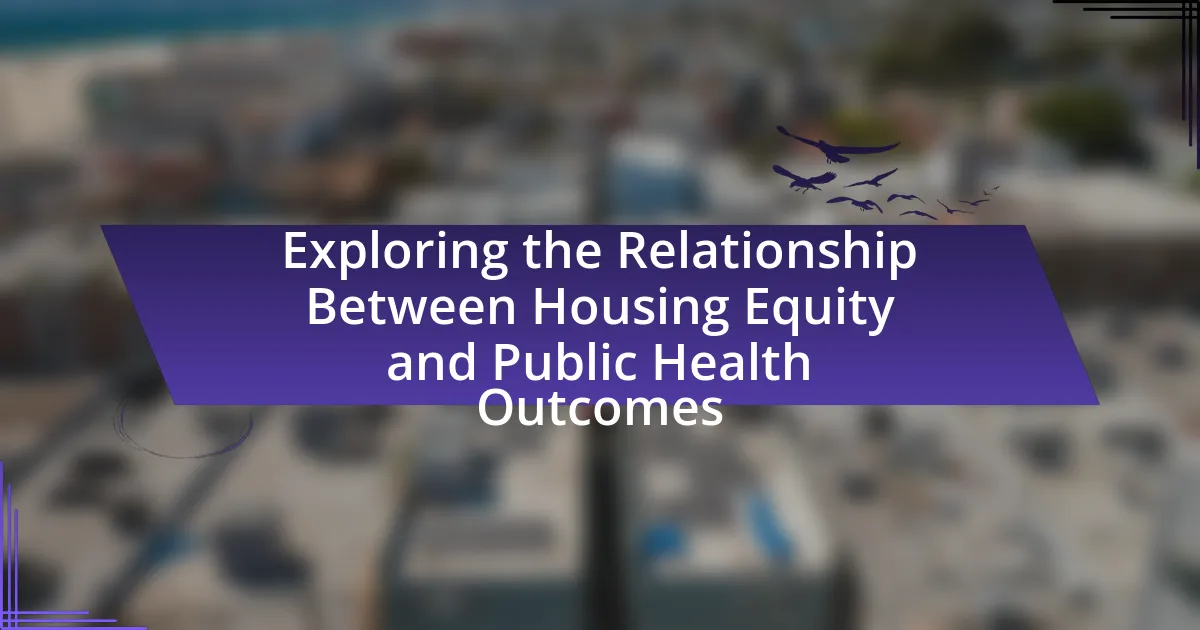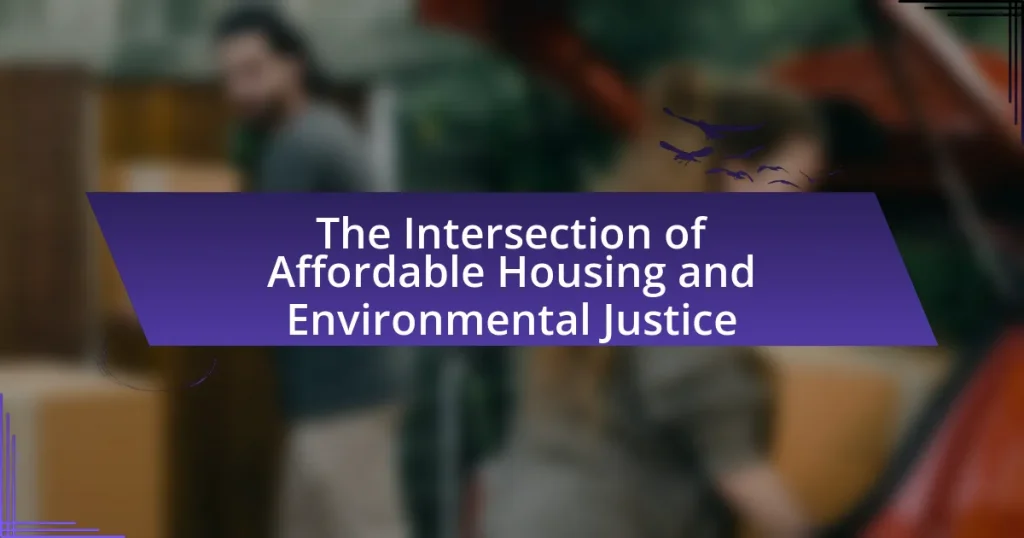The article examines the critical relationship between housing equity and public health outcomes, highlighting how access to safe, stable, and affordable housing directly influences overall well-being. It discusses the impact of housing conditions on public health, linking poor housing to various health issues such as respiratory diseases and mental health disorders. The article also explores the social determinants of health related to housing equity, including income levels, systemic discrimination, and zoning laws, while emphasizing the importance of stable housing for mental health. Additionally, it outlines strategies for improving housing equity, such as enhancing affordable housing development and integrating public health initiatives with housing policies, ultimately aiming to reduce health disparities within communities.

What is the relationship between housing equity and public health outcomes?
Housing equity significantly influences public health outcomes by determining access to safe, stable, and affordable housing, which is essential for overall well-being. Research indicates that individuals living in equitable housing conditions experience lower rates of chronic diseases, improved mental health, and better access to healthcare services. For instance, a study published in the American Journal of Public Health found that neighborhoods with higher housing equity correlate with reduced hospitalization rates and improved health metrics among residents. This relationship underscores the critical role that equitable housing plays in fostering healthier communities and reducing health disparities.
How do housing conditions impact public health?
Housing conditions significantly impact public health by influencing factors such as exposure to environmental hazards, mental health, and access to healthcare services. Poor housing conditions, including overcrowding, inadequate sanitation, and exposure to toxins like lead, can lead to respiratory diseases, infectious diseases, and chronic health issues. For instance, the World Health Organization reports that inadequate housing contributes to approximately 1.4 million deaths annually due to diseases linked to poor living conditions. Furthermore, individuals living in substandard housing often experience higher levels of stress and anxiety, which can exacerbate mental health issues. Access to healthcare can also be limited in areas with poor housing, leading to delayed treatment and worse health outcomes. Thus, the quality of housing directly correlates with the overall health and well-being of individuals and communities.
What specific health issues are linked to poor housing conditions?
Poor housing conditions are linked to several specific health issues, including respiratory diseases, mental health disorders, and infectious diseases. For instance, inadequate ventilation and mold exposure in poorly maintained homes can lead to asthma and other respiratory problems, as evidenced by studies showing a correlation between damp housing and increased asthma prevalence. Additionally, overcrowding and lack of privacy can contribute to stress and anxiety, leading to mental health disorders. Furthermore, substandard housing can facilitate the spread of infectious diseases, as seen in cases where inadequate sanitation and plumbing systems are present, increasing the risk of illnesses such as gastrointestinal infections.
How does housing stability influence mental health?
Housing stability significantly influences mental health by reducing stress and anxiety associated with housing insecurity. Individuals with stable housing experience lower levels of psychological distress, as they are less likely to face the constant worry of eviction or homelessness. Research indicates that stable housing is linked to improved mental health outcomes, with studies showing that individuals who are securely housed report higher levels of well-being and lower rates of depression. For instance, a study published in the American Journal of Public Health found that stable housing can lead to a 30% reduction in mental health issues among low-income populations. This evidence underscores the critical role that housing stability plays in fostering better mental health.
Why is housing equity important for community health?
Housing equity is crucial for community health because it directly influences access to safe, stable, and affordable housing, which is a fundamental determinant of health. When housing is equitable, communities experience lower rates of chronic diseases, improved mental health outcomes, and enhanced overall well-being. Research indicates that individuals living in stable housing conditions are less likely to face health issues such as asthma, obesity, and mental health disorders. For instance, a study published in the American Journal of Public Health found that families in affordable housing reported better health outcomes compared to those in unstable housing situations. Thus, housing equity not only fosters healthier living environments but also contributes to the reduction of health disparities within communities.
What are the social determinants of health related to housing equity?
The social determinants of health related to housing equity include factors such as access to safe and affordable housing, neighborhood conditions, and housing stability. Access to safe and affordable housing directly influences health outcomes by reducing exposure to environmental hazards and stressors associated with unstable living conditions. Neighborhood conditions, including the availability of resources like healthcare, education, and employment opportunities, further impact health by shaping the overall quality of life. Housing stability is crucial, as frequent moves or homelessness can lead to mental health issues and increased vulnerability to chronic diseases. Research indicates that individuals in equitable housing situations experience better health outcomes, highlighting the importance of addressing these determinants to improve public health.
How does housing equity affect access to healthcare services?
Housing equity significantly affects access to healthcare services by determining the financial resources available for health-related expenses and influencing the quality of living conditions. Individuals in equitable housing situations often have better access to healthcare facilities, as they are more likely to reside in neighborhoods with adequate healthcare infrastructure. Research indicates that low-income households, which frequently face housing inequities, experience barriers such as transportation difficulties and lack of nearby healthcare providers, leading to poorer health outcomes. For instance, a study published in the American Journal of Public Health found that individuals living in areas with high housing instability are 50% more likely to delay or forgo necessary medical care. This correlation underscores the critical role that housing equity plays in shaping healthcare accessibility and overall public health outcomes.

What factors contribute to housing equity?
Housing equity is primarily influenced by factors such as income levels, access to affordable housing, and systemic discrimination. Income levels directly affect individuals’ ability to purchase homes or secure favorable rental agreements, thereby impacting their equity. Access to affordable housing is crucial, as it allows lower-income families to build equity over time, while systemic discrimination, including racial and socioeconomic biases, can limit opportunities for certain groups, hindering their ability to accumulate housing equity. According to the U.S. Census Bureau, disparities in homeownership rates among different racial and ethnic groups illustrate the impact of these factors, with white households having a significantly higher homeownership rate compared to Black and Hispanic households, which contributes to the overall inequity in housing wealth.
How do economic policies influence housing equity?
Economic policies significantly influence housing equity by shaping access to affordable housing, financing options, and regulatory frameworks. For instance, policies such as tax incentives for developers can encourage the construction of affordable housing units, thereby increasing availability for low-income families. Additionally, interest rates set by monetary policy affect mortgage affordability; lower rates can enhance homeownership opportunities for marginalized groups, promoting equity. Historical data shows that the implementation of the Community Reinvestment Act in 1977 led to increased lending in underserved communities, improving housing equity by providing access to credit for home purchases.
What role do zoning laws play in housing equity?
Zoning laws significantly influence housing equity by regulating land use and determining where different types of housing can be built. These laws can create barriers to affordable housing development, often favoring single-family homes in affluent neighborhoods while restricting multi-family units in lower-income areas. For instance, a study by the National Low Income Housing Coalition found that restrictive zoning contributes to a shortage of affordable housing, exacerbating income inequality and limiting access to essential services for marginalized communities. Thus, zoning laws play a crucial role in shaping the availability and distribution of housing, directly impacting housing equity.
How does income inequality affect housing access?
Income inequality significantly restricts housing access by creating disparities in affordability and availability of quality housing. Individuals with lower incomes often face challenges in securing safe and adequate housing due to rising property prices and rental costs, which are disproportionately influenced by wealthier populations. For instance, a report from the National Low Income Housing Coalition indicates that in 2021, there was a shortage of 7 million affordable rental homes for extremely low-income renters, highlighting how income inequality exacerbates housing scarcity. This lack of access to affordable housing can lead to overcrowding, homelessness, and negative health outcomes, as individuals are forced to live in substandard conditions or in areas with limited resources.
What demographic factors impact housing equity?
Demographic factors that impact housing equity include race, income, education level, and family structure. Research indicates that racial and ethnic minorities often face systemic barriers in accessing equitable housing opportunities, leading to disparities in homeownership rates. For instance, the U.S. Census Bureau reports that in 2020, homeownership rates for Black Americans were approximately 44.1%, compared to 74.5% for White Americans, highlighting significant racial inequities. Additionally, income levels directly influence housing equity, as lower-income households are more likely to experience housing instability and discrimination in the housing market. Education level also plays a role, with higher educational attainment correlating with increased access to better housing options. Lastly, family structure, such as single-parent households, often faces additional challenges in securing stable housing, further exacerbating inequities.
How do race and ethnicity influence housing opportunities?
Race and ethnicity significantly influence housing opportunities through systemic discrimination and socioeconomic disparities. Studies indicate that minority groups, particularly Black and Hispanic populations, face barriers such as redlining, which restricts access to mortgage loans and affordable housing in desirable neighborhoods. For instance, the Home Owners’ Loan Corporation’s practices in the 1930s systematically denied loans to residents in predominantly Black neighborhoods, leading to long-term disinvestment and reduced property values. Additionally, the U.S. Census Bureau reports that Black and Hispanic households are more likely to experience housing instability and eviction compared to their white counterparts, further exacerbating inequalities in housing access. These factors collectively demonstrate how race and ethnicity shape housing opportunities, contributing to broader disparities in health and economic outcomes.
What is the impact of age and disability on housing equity?
Age and disability significantly impact housing equity by creating barriers to access and affordability. Older adults and individuals with disabilities often face discrimination in housing markets, leading to limited options and higher costs. According to the U.S. Department of Housing and Urban Development, people with disabilities are more likely to experience housing instability, with 30% of renters with disabilities spending more than half of their income on housing. This financial strain exacerbates health disparities, as inadequate housing conditions can lead to negative health outcomes. Additionally, age-related factors, such as mobility limitations, further restrict access to suitable housing, reinforcing inequities in housing opportunities.

How can we improve housing equity to enhance public health outcomes?
Improving housing equity can be achieved by implementing policies that ensure affordable housing access for low-income communities, which directly correlates with enhanced public health outcomes. Research indicates that stable housing reduces stress and improves mental health, as evidenced by a study published in the American Journal of Public Health, which found that individuals in secure housing reported better overall health and lower rates of chronic diseases. Additionally, increasing funding for community health initiatives in underserved areas can address health disparities linked to housing inequities, as highlighted by the National Low Income Housing Coalition, which emphasizes the importance of housing stability in promoting health equity.
What strategies can be implemented to promote housing equity?
To promote housing equity, strategies such as implementing inclusionary zoning, increasing affordable housing development, and enhancing tenant protections can be employed. Inclusionary zoning mandates that a percentage of new developments be affordable for low-income households, which helps integrate diverse income levels within communities. Increasing affordable housing development addresses the supply shortage, as evidenced by the National Low Income Housing Coalition’s report indicating a deficit of 7 million affordable rental homes for extremely low-income renters. Enhancing tenant protections, including rent control and anti-displacement measures, safeguards vulnerable populations from eviction and housing instability, contributing to overall community health and stability.
How can community organizations advocate for better housing policies?
Community organizations can advocate for better housing policies by mobilizing residents, conducting research, and engaging in policy discussions. These organizations often serve as a voice for marginalized communities, highlighting the need for equitable housing solutions. For instance, they can gather data on housing conditions and public health outcomes, demonstrating the correlation between inadequate housing and health disparities. Research from the National Low Income Housing Coalition indicates that stable housing significantly improves health outcomes, reinforcing the argument for policy changes. By presenting this evidence to policymakers, community organizations can effectively push for reforms that promote housing equity and enhance public health.
What role do government programs play in improving housing equity?
Government programs play a crucial role in improving housing equity by providing financial assistance, regulatory support, and targeted initiatives aimed at marginalized communities. These programs, such as the Low-Income Housing Tax Credit and various housing vouchers, help reduce the financial burden on low-income families, enabling them to access affordable housing options. For instance, the National Low Income Housing Coalition reports that housing vouchers can significantly decrease homelessness rates and improve living conditions for disadvantaged populations. Additionally, government regulations that promote fair housing practices help combat discrimination, ensuring equal access to housing opportunities for all individuals, regardless of race or socioeconomic status.
What best practices can communities adopt to address housing-related health issues?
Communities can adopt several best practices to address housing-related health issues, including implementing affordable housing initiatives, enhancing housing quality, and promoting community engagement. Affordable housing initiatives can reduce financial strain on low-income families, thereby improving their overall health outcomes; for instance, studies show that stable housing leads to better mental and physical health. Enhancing housing quality through regular inspections and maintenance can mitigate health risks associated with mold, lead, and other hazards, as evidenced by research indicating that improved housing conditions correlate with decreased respiratory issues. Lastly, promoting community engagement in housing policies ensures that residents’ needs are met, fostering a sense of ownership and responsibility that can lead to healthier living environments.
How can public health initiatives be integrated with housing policies?
Public health initiatives can be integrated with housing policies by aligning health objectives with housing development and regulations. This integration can be achieved through collaborative planning that prioritizes affordable housing, ensuring access to health services, and promoting healthy living environments. For instance, the Centers for Disease Control and Prevention (CDC) emphasizes that housing quality directly impacts health outcomes, as poor housing conditions can lead to respiratory issues and other health problems. By incorporating health assessments into housing policy decisions, such as evaluating the impact of housing on community health metrics, policymakers can create environments that support both housing stability and public health.
What are effective community engagement strategies for housing equity?
Effective community engagement strategies for housing equity include participatory planning, inclusive decision-making, and building partnerships with local organizations. Participatory planning involves actively involving community members in the development and implementation of housing policies, ensuring their voices are heard and needs are addressed. Inclusive decision-making ensures diverse representation, particularly from marginalized groups, which can lead to more equitable outcomes. Building partnerships with local organizations leverages existing community trust and resources, facilitating better communication and collaboration. Research by the Urban Institute highlights that these strategies can significantly improve housing equity by fostering community ownership and accountability in housing initiatives.
What are the key takeaways for improving housing equity and public health?
Key takeaways for improving housing equity and public health include increasing affordable housing availability, enhancing housing quality, and ensuring access to essential services. Research indicates that stable, affordable housing reduces health disparities; for instance, a study by the National Low Income Housing Coalition found that families with stable housing experience lower rates of chronic illnesses. Additionally, improving housing conditions, such as reducing lead exposure and ensuring adequate sanitation, directly correlates with better health outcomes, as evidenced by the Centers for Disease Control and Prevention’s findings on housing-related health hazards. Finally, integrating health services within housing policies can further promote public health, as demonstrated by initiatives that combine housing assistance with healthcare access, leading to improved health metrics among vulnerable populations.



